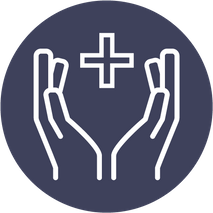
Physical Therapy for Peroneal Tendonitis
AT EVOLVE
Peroneal Tendonitis Physical Therapy
HOW CAN PHYSICAL THERAPY HELP MANAGE SYMPTOMS OF PERONEAL TENDONITIS?
Peroneal tendonitis is a condition involving inflammation or degeneration of the peroneal muscle tendons of the foot and ankle. This occurs when a tendon is overloaded beyond its capacity to withstand repetitive or chronic stress. Pain over the ankle tendon or when contracting the involved muscle, stiffness in the area and even feelings of muscle weakness can indicate tendonitis or tendinopathy. While your initial instinct may be to rest the ankle until symptoms subside, a physical therapist can show you a more proactive approach that will heal the injured tendon, help you return to activities without pain and prevent the recurrence of tendonitis in the future.
WHAT DOES PHYSICAL THERAPY FOR PERONEAL TENDONITIS LOOK LIKE?
Physical therapy for peroneal tendonitis is two-pronged. First, we aim to reduce symptoms of pain, inflammation and discomfort while restoring full flexibility and strength. Second, we look to address any underlying factors in order to limit symptom recurrence. My team of therapists and I will start by getting to know your concerns and goals and performing a thorough physical exam to determine what areas we should target with our physical therapy interventions. Your therapist may employ manual therapy interventions to target joint and tissue mobility while also prescribing movements and exercises for strength, motor control and mobility to be performed in the home and the clinic.
WHEN WILL I BEGIN TO SEE RESULTS?
The duration of your physical therapy plan of care is based on many different factors including the severity of your symptoms and the number and type of underlying factors your therapy is looking to address. While full resolution of symptoms can take time, you may begin to see some results right away. You should experience improvements in many symptoms such as pain, stiffness, and inflammation within a couple of weeks but making meaningful changes in strength, flexibility and overall mobility in order to provide long-term relief may take longer. Achieving long lasting results may take some time, but dedication to your program will not only help you achieve these results but will help to decrease the likelihood of symptoms recurring in the future.
THE PERONEAL TENDONS
The peroneal muscles, formerly called the fibularis muscles, consist of the peroneus longus and peroneus brevis which lie on the outside of the lower leg. As the name implies, the peroneus longus is the longer of the two muscles. It originates up at the top of the tibia and fibula. The muscle runs down the lateral lower leg where midway down it tapers into a long tendon which continues along the outside of the ankle and beneath the foot. The peroneus brevis originates on the bottom two thirds of the fibula bone. Its tendon also runs along the outside of the ankle but it inserts on the outside of the foot.
These two muscles work together to evert the foot or move it outward and they assist in pointing the foot, an action known as plantarflexion. They also stabilize the ankle against inversion forces such as when you accidentally roll your ankle outward. Finally, the peroneus longus helps maintain the arch of the foot. Together these muscles play an important role in normal gait as well as in more athletic motions such as running, jumping, cutting and more.
TENDONITIS AND TENDINOPATHY OF THE PERONEAL MUSCLES
Tendons are a type of fibrous connective tissue that connect muscles to bones. Tendons have unique properties and serve important functions including:
- Tendons help to move our bones and amplify the effect of muscle contractions
- They act as shock absorbers
- Tendons are strong but they are not designed to stretch or deform easily
- They can become weaker or stronger/stiffer in response to a training stimulus
- Training can make a tendon more prone to or more resilient against, injury.
-
An aching pain on the outside of the ankle that increases with activity and often decreases with rest.
Pain and weakness when trying to move the ankle outward or push off the toe
Swelling and tenderness behind the outside ankle bone where the tendons lie
Pain when running, walking across a sloped terrain, jumping or changing directions quickly
End Injury Progression
Physical therapy for Peroneal Tendonitis has proven to prevent injury, slow and even stop pain issues, improve performance, and reverse injury progression in many cases.
Relieve Pain
The movements used in this technique can target your entire body helping you to manage discomfort and pain during the course of your physical therapy treatments.
Improve Range of Motion
Posture awareness is an important area to focus on due to the fact that certain positions may cause you further discomfort and pain.
Restore Mobility
You can regain mobility and flexibility by taking part in the stretches and exercises as prescribed by your physical therapist.
How Long Will Physical Therapy for PERONEAL TENDONITIS Last?
PHYSICAL THERAPY FOR PERONEAL TENDONITIS
My team of therapists and I will always create an individualized treatment plan for your ankle symptoms but below are some general treatment approaches for peroneal tendonitis or tendinopathy:
As mentioned above, physical therapy to address tendonitis is a two-pronged approach. Providing symptom relief is a primary goal of physical therapy for this condition but in order to minimize the likelihood of recurrent bouts of tendonitis, tendinopathy or a more severe tendon injury, addressing tendon stiffness plus identifying underlying contributing factors and making a plan to address them is vital.
If inflammation is present around the tendon in the early stages of injury your physical therapist may utilize modalities like ultrasound, electrical stimulation or ice to address inflammation and ankle pain. They will educate you on how to modify activity and minimize discomfort and irritation around the ankle. Then they focus on restoring strength, flexibility and ankle mechanics.
Many of our clients seek care when their tendon injury has become chronic. With tendinopathy, inflammation is often not the culprit of your symptoms and a more active approach to tendon recovery is indicated. In this case there will be more emphasis on interventions that will help remodel the structure of the tendon. The goal of treatment for tendinopathy is to apply graded stress to the tendon and increase its stiffness so that it becomes more resilient to the repetitive forces of your work tasks and favorite sports.
To do this correctly, your PT will guide you on appropriate dosing of specific ankle exercises which place more load on the tendon over time. They may also utilize tools such as ASTYM or Graston to encourage collagen production and remodeling. Finally, addressing other contributing factors such as impairments in strength, flexibility, coordination and motor control in adjacent muscles and joints can help ensure excessive stress is not placed on the peroneal tendons as you return to your previous activities. All of these things together will help you resume your previous activities with greater confidence, resilience and a knowledge of how to manage this condition in the future.
Peroneal tendonitis can certainly put a damper on your favorite activities but physical therapy can help you find a lasting solution. Stop the cycle of rest and repeat and call Evolve Physical Therapy today. Our team of physical therapists is ready to help you heal that tendon and get back to the activities you love.
Mill Basin (located in Harbor Fitness)
6161 Strickland Ave
Brooklyn, NY 11234
Monday: 7am-8pm
Tuesday: 7am-8pm
Wednesday: 8am-5pm
Thursday: 7am-8pm
Friday: 8am-1pm
Park Slope (located in Harbor Fitness)
550 5th Ave.
Brooklyn, NY 11215
Monday: 9am-8pm
Tuesday: 8am-6pm
Wednesday: 9am-8pm
Thursday: 8am-6pm
Friday: 8am-3pm
Gravesend
372 Avenue U
Brooklyn, NY 11223
Monday-Thursday: 8am-8pm
Friday: 8am-3pm
Kings Highway
945 Kings Highway
Brooklyn, NY 11223
Monday-Wed.: 12pm-8pm
Ready to take the next step to a healthier you?
Contact Us Today!
PHYSICAL THERAPY FOR PERONEAL TENDONITIS
Need physical therapy for Peroneal Tendonitis?
Let our caring and compassionate physical therapists help you with relieving pain while getting you back on your feet comfortably.
Call now to schedule your first PT consultation free of charge.
Call: 1-718-258-3300







